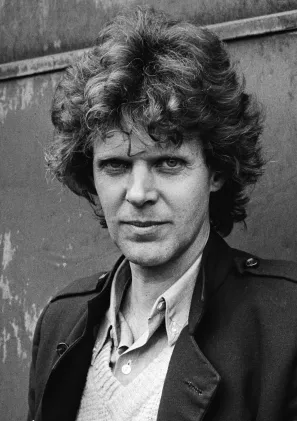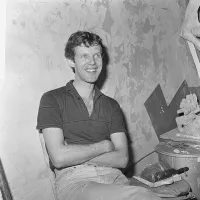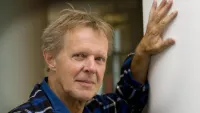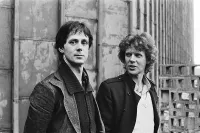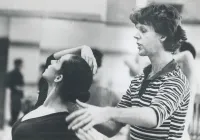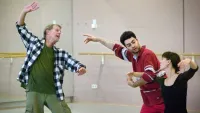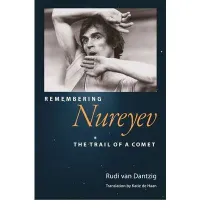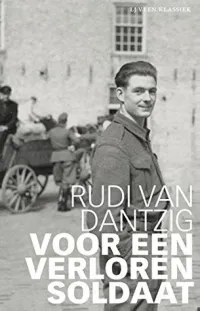Biography
1933 - 2012
Born in Amsterdam on August 4 1933, Rudi van Dantzig was six when Germany invaded the Netherlands. At 15, he saw the film The Red Shoes and knew he wanted to be a dancer. The following year he began taking lessons. Though at 16 he would have typically been considered too old to start his training, male dancers were in short supply during the post war period, and his enthusiasm and work ethic were difficult to deny. In 1952, the 18 year old was asked by teacher Sonia Gaskell to join her Ballet Recital, a company she later developed into the Dutch National Ballet. Three years later he choreographed the first of his 51 ballets, Night Island. As a choreographer, van Dantzig’s provocative work focused primarily on contemporary themes, blending dark psychological content with expressive dancing, and capturing the mood of the 1960s with groundbreaking subject matter. Monument for a Dead Boy (1965) was set to electronic music and depicted an adolescent discovering his gay identity during intolerant times. The work garnered international praise and Rudolf Nureyev asked to perform it with Dutch National Ballet. The role was originally danced by van Dantzig’s partner, Toer van Schayk, who also designed many of his sets. Another example of van Dantzig’s socially conscious work was the 1971 ballet Painted Birds which featured projected images and was about both personal and environmental pollution. In 1969 van Dantzig became artistic co-director of the Dutch National Ballet, eventually becoming sole director from 1971-1991, and remaining as choreographer until 1994. Van Dantzig also won acclaim as a writer. In 1986 he penned the autobiographical novel For a Lost Soldier, about a gay youth evacuated during WWII and his eventual sexual relationship with a soldier. He also wrote biographies about Nureyev, who danced in three of van Dantzig’s ballets, and gay Dutch resistance fighter Willem Arondéus. Van Dantzig died on January 19, 2012 at age 78 of cancer at his home in Amsterdam and was survived by his partner, dancer/designer van Schayk.
1933 - 2012
Born in Amsterdam on August 4 1933, Rudi van Dantzig was six when Germany invaded the Netherlands. At 15, he saw the film The Red Shoes and knew he wanted to be a dancer. The following year he began taking lessons. Though at 16 he would have typically been considered too old to start his training, male dancers were in short supply during the post war period, and his enthusiasm and work ethic were difficult to deny. In 1952, the 18 year old was asked by teacher Sonia Gaskell to join her Ballet Recital, a company she later developed into the Dutch National Ballet. Three years later he choreographed the first of his 51 ballets, Night Island. As a choreographer, van Dantzig’s provocative work focused primarily on contemporary themes, blending dark psychological content with expressive dancing, and capturing the mood of the 1960s with groundbreaking subject matter. Monument for a Dead Boy (1965) was set to electronic music and depicted an adolescent discovering his gay identity during intolerant times. The work garnered international praise and Rudolf Nureyev asked to perform it with Dutch National Ballet. The role was originally danced by van Dantzig’s partner, Toer van Schayk, who also designed many of his sets. Another example of van Dantzig’s socially conscious work was the 1971 ballet Painted Birds which featured projected images and was about both personal and environmental pollution. In 1969 van Dantzig became artistic co-director of the Dutch National Ballet, eventually becoming sole director from 1971-1991, and remaining as choreographer until 1994. Van Dantzig also won acclaim as a writer. In 1986 he penned the autobiographical novel For a Lost Soldier, about a gay youth evacuated during WWII and his eventual sexual relationship with a soldier. He also wrote biographies about Nureyev, who danced in three of van Dantzig’s ballets, and gay Dutch resistance fighter Willem Arondéus. Van Dantzig died on January 19, 2012 at age 78 of cancer at his home in Amsterdam and was survived by his partner, dancer/designer van Schayk.
Demography
Demography
Gender Male
Sexual Orientation Gay
Gender Identity Cisgender
Ethnicity Caucasian/White
Nations Affiliated Netherlands
Era/Epoch Cold War (1945-1991) Information Age (1970-present) World War II (1939-1945)
Field(s) of Contribution
Author
Dance
Theater
World History
Demography
Gender Male
Sexual Orientation Gay
Gender Identity Cisgender
Ethnicity Caucasian/White
Nations Affiliated Netherlands
Era/Epoch Cold War (1945-1991) Information Age (1970-present) World War II (1939-1945)
Field(s) of Contribution
Author
Dance
Theater
World History
Resources
Resources
Campbell, R.M. "On Stage at PNB Dance Work from a Dutch Master." Seattle Post-Intelligencer (January 27, 1998): D1.
Dantzig, Rudi van. For a Lost Soldier. Arnold J. Pomerans, trans. London: Bodley Head, 1991.
Klooss, Helma. "Dostoyevski of the Dance." Dance Magazine 67.11 (November 1993): 92.
Loney, Glenn. "Evolution of an Ensemble: Rudi van Dantzig on the National Ballet of Holland." Dance Magazine 48.3 (March 1974): 34-39.
Perceval, John. "The Voice of the People." Dance and Dancers 448 (May-June 1987): 32-34.
Utrecht, Luuk. Rudi van Dantzig: A Controversial Idealist in Ballet. Nicoline Gatehouse, trans. Zutphen, The Netherlands: Walburg Press, 1993.
Utrecht, Luuk. "Rudi van Dantzig." International Encyclopedia of Dance. Selma Jeanne Cohen, ed. New York: Oxford University Press, 1998. 2:346-348.
http://en.wikipedia.org/wiki/Rudi_van_Dantzig
http://www.theguardian.com/stage/2012/jan/23/rudi-van-dantzig
Resources
Campbell, R.M. "On Stage at PNB Dance Work from a Dutch Master." Seattle Post-Intelligencer (January 27, 1998): D1.
Dantzig, Rudi van. For a Lost Soldier. Arnold J. Pomerans, trans. London: Bodley Head, 1991.
Klooss, Helma. "Dostoyevski of the Dance." Dance Magazine 67.11 (November 1993): 92.
Loney, Glenn. "Evolution of an Ensemble: Rudi van Dantzig on the National Ballet of Holland." Dance Magazine 48.3 (March 1974): 34-39.
Perceval, John. "The Voice of the People." Dance and Dancers 448 (May-June 1987): 32-34.
Utrecht, Luuk. Rudi van Dantzig: A Controversial Idealist in Ballet. Nicoline Gatehouse, trans. Zutphen, The Netherlands: Walburg Press, 1993.
Utrecht, Luuk. "Rudi van Dantzig." International Encyclopedia of Dance. Selma Jeanne Cohen, ed. New York: Oxford University Press, 1998. 2:346-348.
http://en.wikipedia.org/wiki/Rudi_van_Dantzig
http://www.theguardian.com/stage/2012/jan/23/rudi-van-dantzig
